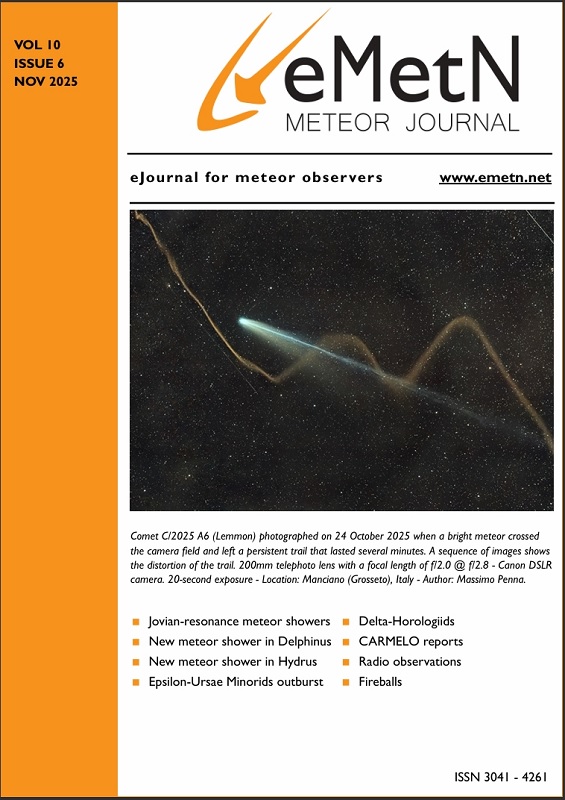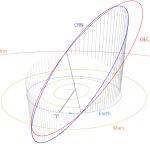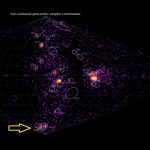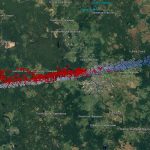As seen from the northern hemisphere, June is another slow month for meteor activity. There are no major showers active in June and only the Anthelion source can be counted on for continuous activity. Sporadic rates continue to remain low as seen from the mid-northern hemisphere (45 N) with only half the rates that are seen from the mid-southern hemisphere. For the upper half of the northern hemisphere the nights are short to non-existent this time of year. As seen from the southern tropics (25 S) sporadic rates continue to be strong this month with morning hourly rates near 10.
During this period, the moon reaches its first quarter phase on Tuesday June 3rd. At that time the moon will lie 90 degrees east of the sun and will set near 02:00 local summer time (LST). This weekend the crescent moon will set late evening hours and will not interfere with meteor observing during the more active morning hours. The estimated total hourly rates for evening observers this weekend should be near 2 as seen from mid-northern latitudes (45N) and 3 as seen from tropical southern locations (25S). For morning observers, the estimated total hourly rates should be near 7 as seen from mid-northern latitudes (45N) and 10 as seen from tropical southern locations (25S). Evening rates are reduced due to lunar interference. The actual rates seen will also depend on factors such as personal light and motion perception, local weather conditions, alertness, and experience in watching meteor activity. Note that the hourly rates listed below are estimates as viewed from dark sky sites away from urban light sources. Observers viewing from urban areas will see less activity as only the brighter meteors will be visible from such locations.
The radiant (the area of the sky where meteors appear to shoot from) positions and rates listed below are exact for Saturday night/Sunday morning May 31/June 1. These positions do not change greatly day to day so the listed coordinates may be used during this entire period. Most star atlases (available online and at bookstores and planetariums) will provide maps with grid lines of the celestial coordinates so that you may find out exactly where these positions are located in the sky. I have also included charts of the sky that display the radiant positions for evening, midnight, and morning. The center of each chart is the sky directly overhead at the appropriate hour. These charts are oriented for facing south but can be used for any direction by rotating the charts to the desired direction. A planisphere or computer planetarium program is also useful in showing the sky at any time of night on any date of the year. Activity from each radiant is best seen when it is positioned highest in the sky, either due north or south along the meridian, depending on your latitude. Radiants that rise after midnight will not reach their highest point in the sky until daylight. For these radiants, it is best to view them during the last few hours before dawn. It must be remembered that meteor activity is rarely seen at its radiant position. Rather they shoot outwards from the radiant, so it is best to center your field of view so that the radiant lies toward the edge and not the center. Viewing there will allow you to easily trace the path of each meteor back to the radiant (if it is a shower member) or in another direction if it is sporadic. Meteor activity is not seen from radiants that are located far below the horizon. The positions below are listed in a west to east manner in order of right ascension (celestial longitude). The positions listed first are located further west therefore are accessible earlier in the night while those listed further down the list rise later in the night.
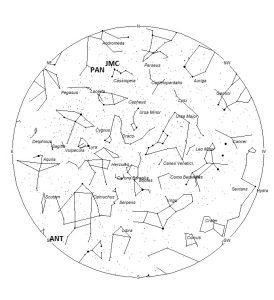
Radiant Positions at 23:00 Local Summer Time

Radiant Positions at 01:00 Local Summer Time
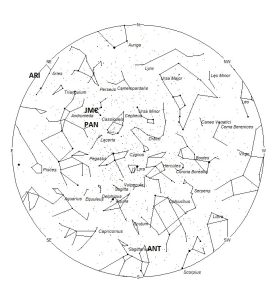
Radiant Positions at 03:00 Local Summer Time
These sources of meteoric activity are expected to be active this week
.
The large Anthelion (ANT) radiant is currently centered at 17:36 (264) -23. This position lies in southeastern Ophiuchus, 3 degrees northeast of the 3rd magnitude star known as theta Ophiuchi. Since this radiant is so large, activity from this source may also appear from western Sagittarius and eastern Scorpius as well as Ophiuchus. This radiant is best placed near 02:00 LST when it lies on the meridian and highest in the southern sky. Rates at this time should be near 2 per hour as seen from the northern hemisphere and 3 as seen from south of the equator. With an entry velocity of 30 km/sec., the average Anthelion meteor would be of medium-slow velocity.
The psi Andromedids (PAN) were first detected by Dr. Peter Jenniskens and reported in the second edition of new radiants discovered by CAMS (2018). These meteors are active from May 31-June 4 with a sharp maximum activity occurring on June 2nd. The radiant on the night of maximum activity is located at 23:41 (355) +47. This area of the sky is located in northwestern Andromeda, just west of the faint star known as psi Andromedae (see the nightly charts). This area for the sky is best placed during the last hour prior to dawn when it lies highest in the northeastern sky. Rates are most likely less than 1 per hour at maximum so care must be taken when reporting these meteors. With an entry velocity of 50 km/sec., these meteors would be medium-fast.
The June mu Cassiopeiids (JMC) were first detected by CMOR2 radar observations (Dr. Peter Brown et al., 2010). These meteors are active from May 31-June 5 with a maximum activity occurring on June 2nd. At maximum, the radiant is located at 00:43 (011) +53, which places it in southern Cassiopeia, 2 degrees southeast of the magnitude star known as Fulu (zeta Cassiopeiae). This area for the sky is best placed during the last hour prior to dawn when it lies highest in the northern sky. These meteors are not well seen from the southern hemisphere due to its high northern location. Rates may reach 1 per hour at maximum as seen from the northern hemisphere. With an entry velocity of 51 km/sec., these meteors would be medium-fast. Being that these meteors were discovered by radar, a majority of the activity is most likely faint.
The Daytime Arietids (ARI) are active from a radiant located at 02:37 (039) +23. This position lies in western Aries, 5 degrees east of the 2nd magnitude star known as Hamal (alpha Arietis). This position is also approximately 45 degrees west of the sun, therefore these meteors are only visible just before the break of dawn. Face toward the eastern half of the sky to see these meteors shoot upward from the eastern horizon. Hourly rates are expected to be less than 1 at this time. With an entry velocity of 40 km/sec., the average meteor from this source would have a medium velocity. This is the strongest daylight shower of the year and radio observers always look forward to the second week of June when it reaches maximum activity.
Sporadic meteors are those meteors that cannot be associated with any known meteor shower. All meteor showers are evolving and disperse over time to the point where they are no longer recognizable. Away from the peaks of the major annual showers, these sporadic meteors make up the bulk of the activity seen each night. As seen from the mid-northern hemisphere (45N) one would expect to see during this period approximately 6 sporadic meteors per hour during the last hour before dawn as seen from rural observing sites. Evening rates would be near 1 per hour. As seen from the tropical southern latitudes (25S), morning rates would be near 10 per hour as seen from rural observing sites and 2 per hour during the evening hours. Locations between these two extremes would see activity between these listed figures. Evening rates are reduced by moonlight.
The list below offers the information in tabular form of the showers that I feel are within reach of the visual observer to discern. Hourly rates are often less than one, so these sources are rarely listed as visual targets in most meteor shower lists. If you are like me and wish to associate as many meteors as possible with known sources, then you will appreciate these listings. Before listing meteors from class IV showers, you should attempt to prove these meteors belong to them and are not chance alignments of sporadic meteors. You can note parameters such as duration, length, radiant distance and the elevation of each meteor to help compute the probability of shower association. It should be remembered that slow meteors can be seen from fast showers, but fast meteors cannot be produced from slow showers. Slower showers are those with velocities less than 35/km per second. Slow meteors can appear from fast showers when they appear close to the radiant or low in the sky. The table located on page 22 of the IMO’s 2025 Meteor Shower Calendar is a big help in aiding in the identification of meteors. If you record the length and duration of each meteor, you can use this chart to check the probability of the meteor belonging to a shower of known velocity. If the angular velocity is similar to the figure in the table, then your meteor probably belongs to that shower. Rates and positions in the table are exact for Saturday night/Sunday morning.
| SHOWER | DATE OF MAXIMUM ACTIVITY | CELESTIAL POSITION | ENTRY VELOCITY | CULMINATION | HOURLY RATE | CLASS |
| RA (RA in Deg.) DEC | Km/Sec | Local Summer Time | North-South | |||
| Anthelion (ANT) | – | 17:36 (264) -23 | 30 | 02:00 | 1 -2 | II |
| psi Andromedids (PAN) | Jun 02 | 23:41 (355) +47 | 50 | 08:00 | <1 – <1 | IV |
| June mu Cassiopeiids (JMC) | Jun 02 | 00:43 (011) +53 | 51 | 09:00 | <1 – <1 | IV |
| Daytime Arietids (ARI) | Jun 10 | 02:37 (039) +23 | 40 | 11:00 | <1 – <1 | IV |
You can keep track of the activity of these meteor showers as well as those beyond the limits of visual observing by visiting the NASA Meteor Shower Portal. You can move the sky globe to see different areas of the sky. Colored dots indicate shower meteors while white dots indicate sporadic (random) activity. The large orange disk indicates the position of the sun so little activity will be seen in that area of the sky.
Class Explanation: A scale to group meteor showers by their intensity:
- Class I: the strongest annual showers with Zenith Hourly Rates normally ten or better.
- Class II: reliable minor showers with ZHR’s normally two to ten.
- Class III: showers that do not provide annual activity. These showers are rarely active yet have the potential to produce a major display on occasion.
- Class IV: weak minor showers with ZHR’s rarely exceeding two. The study of these showers is best left to experienced observers who use plotting and angular velocity estimates to determine shower association. These weak showers are also good targets for video and photographic work. Observers with less experience are urged to limit their shower associations to showers with a rating of I to III.

